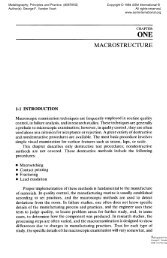Vacuum Melting and Remelting Processes - ASM International
Vacuum Melting and Remelting Processes - ASM International
Vacuum Melting and Remelting Processes - ASM International
Create successful ePaper yourself
Turn your PDF publications into a flip-book with our unique Google optimized e-Paper software.
<strong>ASM</strong> H<strong>and</strong>book Volume 15: Casting (#05115G)<br />
materials in terms of material quality,<br />
size, <strong>and</strong> shape<br />
• The different methods of material pro-<br />
cessing available<br />
• Product quality, size, <strong>and</strong> quantity<br />
Contamination-free<br />
environment <strong>and</strong><br />
crucible<br />
Material evaporation.-- ,<br />
<strong>and</strong> splattering<br />
Reflected \..~__.~,<br />
electron beam<br />
X-ray emission<br />
Flexible melting rate<br />
<strong>and</strong> refining<br />
dwell time<br />
Feedstock<br />
Fig. 1 Schematic of the electron beam melting process<br />
(a)<br />
li' i<br />
~! (f)<br />
Contamination of the product is avoided by<br />
melting in a controlled vacuum <strong>and</strong> in wa-<br />
ter-cooled copper crucibles (Fig. 1).<br />
The energy efficiency of electron beam<br />
processing exceeds that of competing pro-<br />
Electron beam gun<br />
Flexible power <strong>and</strong><br />
power distribution<br />
<strong>Vacuum</strong> <strong>Melting</strong> <strong>and</strong> <strong>Remelting</strong> <strong>Processes</strong> / 411<br />
Scanning electron beam<br />
Drip melt area<br />
Refining in the<br />
pool zone<br />
i ( , ' ) ~ (g) (h)<br />
Water-cooled copper crucible<br />
Continuous casting <strong>and</strong><br />
solidifying ingot<br />
Fig. 2 Examples of electron beam melting <strong>and</strong> casting processes. (a) Button melting with controlled solidification<br />
for quantitative determination of low-density inclusions. (b) Consolidation of raw material, chips, <strong>and</strong> solid<br />
scrap to consumable electrodes for vacuum arc or electron beam remelting. (c) Drip melting of horizontally or vertically<br />
fed feedstocks. (d) Continuous flow refining/melting. (e) Floating zone melting. (f) Investment casting. (g) Pelletizing<br />
(manufacture of pellets from scrap <strong>and</strong> other materials for scrap recycling). (h) Atomization <strong>and</strong> granulation of<br />
refractory <strong>and</strong> reactive metals<br />
(e) (b) /~<br />
Copyright © 2008 <strong>ASM</strong> <strong>International</strong> ®<br />
All rights reserved.<br />
www.asminternational.org<br />
cesses because of the control of the beam<br />
spot dwell time <strong>and</strong> distribution at the areas<br />
to be melted or maintained as liquid. In<br />
addition, unnecessary heating of the ingot<br />
pool, as occurs in vacuum arc remelting, for<br />
example, is avoided. Power losses of the<br />
electron beam inside the gun <strong>and</strong> between<br />
the gun nozzle <strong>and</strong> the target are very small,<br />
but approximately 20% of the beam power<br />
is lost because of beam reflection, radiation<br />
of the liquid metal, <strong>and</strong> heat conductivity of<br />
the water-cooled trough <strong>and</strong> crucible walls.<br />
Electron Beam <strong>Melting</strong><br />
<strong>and</strong> Casting <strong>Processes</strong><br />
From the large variety of electron beam<br />
melting <strong>and</strong> casting processes shown in Fig.<br />
2 only the processes illustrated in (a), (c),<br />
(d), <strong>and</strong> (f) are related to processes used in<br />
foundry technology:<br />
• Button melting processes for the quality<br />
control of steel <strong>and</strong> superalloy cast parts<br />
to control the content of low-density in-<br />
clusions<br />
• Drip melting process for the preparation<br />
of refractory <strong>and</strong> reactive metal feedstock<br />
material for electron beam <strong>and</strong> VAR skull<br />
melting <strong>and</strong> casting<br />
• Continuous flow melting process for the<br />
feedstock refining of superalloys for VIM<br />
<strong>and</strong> electron beam casting<br />
• Electron beam investment casting process<br />
Electron Beam Heat<br />
Source Specifmcat,ons<br />
For all electron beam melting <strong>and</strong> casting<br />
processes, except for the crucible-free float-<br />
ing zone melting process, Pierce-type elec-<br />
tron beam guns with separately evacuated<br />
beam generating <strong>and</strong> prefocusing rooms are<br />
the key components of the furnaces used.<br />
The essential features of these guns are:<br />
• Large power range of 0 to 1200 kW<br />
• Long free beam path of 250 to 1500 mm<br />
(10 to 60 in.) <strong>and</strong> the adjustable beam<br />
power distribution<br />
• Beam deflection angle of ---45 ° <strong>and</strong> spot<br />
frequency up to 500 Hz<br />
Schematics of electron beam consolidation <strong>and</strong> drip melting processes. (a) Consolidation of coarse <strong>and</strong> solid scrap. (b) Continuous consolidation of raw material, chips,<br />
Fig. 3 <strong>and</strong> solid scrap by direct feeding into a continuous casting crucible. (c) Drip melting of horizontally fed compacts, sintered bars, or consolidates for initial melting of<br />
reactive <strong>and</strong> refractory metals. (d) Drip melting of vertically fed vacuum induction melted or conventionally melted electrodes. (e) Drip melting of horizontally <strong>and</strong> vertically fed<br />
materials for the production of alloys from feedstocks with very different melting points
















